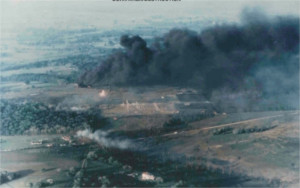A unconfined vapour cloud explosion (UVCE) occurred on the above-ground installations of an underground LPG storage. The Brenham storage facility consists of a 60 000 m3 cavern filled with LPG (actually, a mixture of 1/3 propane, 1/3 ethane, 20% n-butane and 10% pentane/isopentane). The cavern is linked to ground level by a 34 cm, 810 m long cemented casing. A 860 m long tubing allows injection/withdrawal of brine. LPG is injected to or withdrawn from three distinct pipelines. Brine is provided by two above-ground brine ponds. The wellhead is equipped with a shut-down valve. The Brenham station is operated remotely by a dispatcher in Tulsa, Oklahoma (750 km away). At 5:43 a.m. LPG was injected in the cavern. The brine/LPG interface unexpectedly reached the 2.5 cm diameter weep hole located in the lower part of the tubing, 30 cm above the tubing base. The weep hole is supposed to provide warning in case of imminent overfilling. LPG flew into the tubing, leading to lower density in the fluid central column, partial vaporization, expansion of the lighter gases, a pressure drop in the cavern and, ultimately, a larger flow of gas through the weep hole and the tubing base alike. Brine, followed by liquefied gas, erupted at the brine pond surface. Back-calculation proved that 500 to 1 600 m3 of liquefied gases were expelled.
The release of gas in the atmosphere activated gas detectors at ground level (such activation was a relatively frequent event at this station, often unrelated to an actual gas leak). The dispatcher in Tulsa was not able to interpret correctly the somewhat confusing information delivered by the telemetric system. Indeed, a unique signal was sent, whatever the number of activated detectors. The shut-down valve (or cavern safety valve) was assumed to react immediately to high pressure levels 0.7 MPa in the brine tubing at the wellhead, but the system failed.
A heavier-than-air gas cloud, 10 m high, developed above the station. Employees blocked routes to prevent access to the station. Despite, a car entered the foggy cloud at 7:08 a.m. and ignited the gas, resulting in a severe explosion (readings of 3.5 to 4 were recorded on the Richter scale), and three people died from injuries received. An additional 21 people were treated for blunt force trauma, lacerations, and burn injuries at area hospitals. The surface blast demolished all buildings at the Brenham station and caused varying degrees of damage to ail homes within a 7.8 km2 area. Total costs were estimated at 9 M dollars.
The accident analysis carried out by the national transport safety board (NTSB) identified several causes for the accident:
- Underestimation of the amount of stored LPG (52 500 m3, were actually stored, instead of 45 800 m3, estimated) due to metering inaccuracy, inability to balance gas input/output, poor knowledge of LPG density in the column, employee miscalculations (furthermore, pond saturated-brine had been sold to drillers, leading to injection of undersaturated brine and additional dissolutioncavity volume had increased by a factor of 9 from 1981 to 1991), and inadequate location of the weep hole, leading to late overfilling warning. The distance between the tubing base and the weep hole was made 1.8 m in the later re-design of the facility, instead of 0.3 m in the 1992 configuration.
- Insufficiently detailed information transmitted to the dispatcher board.
- Failure of the emergency shut-down system valve. This system included a brine pressure-sensing line; large pressure build-up in the line switched a spring that, when triggered, sent an electrical signal in a chain containing a fusible link whose fusion closed the safety valve. It is extremely likely than one or two manual valves were closed on the sensing line, isolating it from main body of the brine tube and making the emergency system ineffective. Ironically, the gas ignition activated the shut-down valve when heat from the explosion burned the fuse.
After this accident, the Railroad Commission of Texas promulgated new regulations mandating that LPG storage caverns be protected by two overfill detection and automatic shut-in methods.





